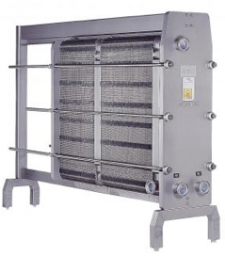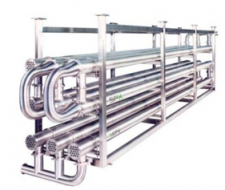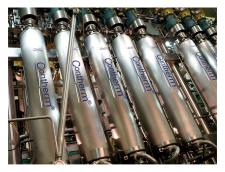
There are many variables to consider when choosing the right heat exchanger for your sanitary process – from the scientific to the technical to the practical:
The main classifications of sanitary process heat exchangers – plate and scraped surface –possess different characteristics and options that can be combined to meet the needs of any manufacturing operation. Selecting and applying appropriate sanitary process components will help maximize resources, production efficiency, and product quality.
Here’s a look at each heat exchanger type, their strengths, and the applications in which they excel:
 Plate-style heat exchangers are the choice for many simple applications because they maximize efficiency and reliability. Their large transfer areas and stainless steel design give them extremely high wall shear stress, making the plate variety the most efficient class of heat exchangers.
Plate-style heat exchangers are the choice for many simple applications because they maximize efficiency and reliability. Their large transfer areas and stainless steel design give them extremely high wall shear stress, making the plate variety the most efficient class of heat exchangers.
The large plates create considerable agitation, making them ideal for many low-viscosity materials; this combination of low-viscosity media and turbulent agitation also makes them resistant to fouling. Pairs of plates can be removed individually for maintenance, cleaning, or replacement. Plates also can be added to increase capacity without appreciably increasing the heat exchangers’ footprint. Another advantage of plate is exchangers is their low initial cost, as well as easy and inexpensive operation.
The trade-off is that plate exchangers often are not suitable for higher viscosities or for liquids containing particulates or for processing under high pressure.

For heating or cooling more viscous materials or those containing suspended solids, tubular heat exchangers are probably the best option because of their gentle product-handling characteristics that maintain the material’s integrity throughout the process. While they are not as thermally efficient as plate exchangers, their welded design is preferable when dealing with extreme temperatures and pressures.
Common in food and beverage processing, where the modular components can handle distillation, pasteurization, boiling and other heavy-duty applications, tubular heat exchangers can operate for extended periods required in many continuous processes. Their modular design also makes tubular exchangers highly scalable and adaptable to manufacturing changeovers.

When neither plate nor tubular heat exchangers can handle a material’s viscosity or particulate size, scraped surface heat exchangers can get the job done.
Ideal for working with heat-sensitive or delicate products, scraped surface exchangers continually churn the fluid, moving to the surface and back again quickly, making for faster heating or cooling rates.
Rodem’s extensive product line, process expertise, and relationships with the industry’s most respected manufacturers ensures we can help you select the heat exchanger that is perfect for your needs. Call us today at 800-543-7312 to find the Alfa Laval or SPX heat exchanger that will maximize your applications’ efficiency.
